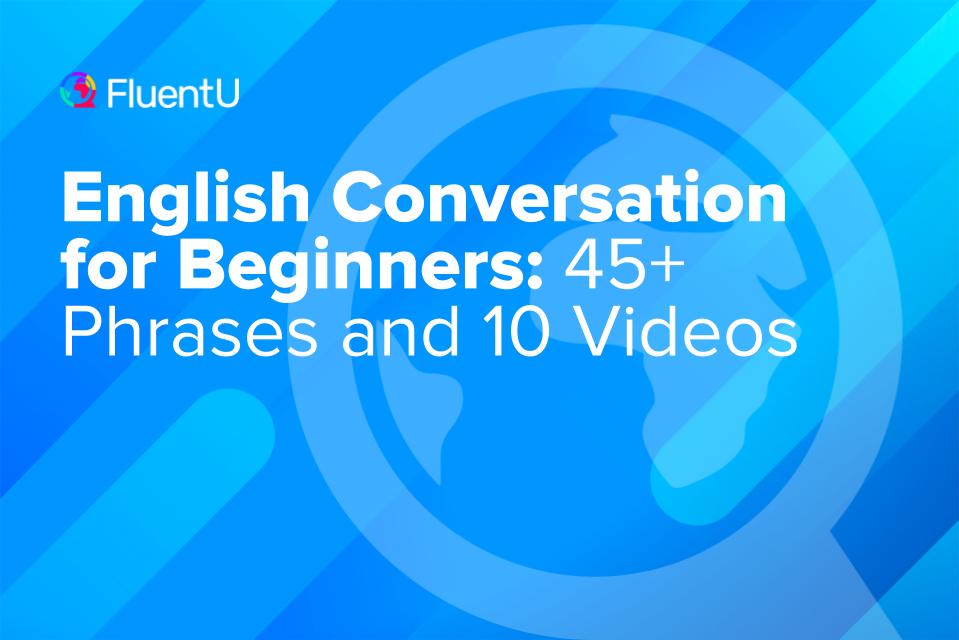Contents
English Conversation for Beginners: 45+ Phrases and 10 Videos

Did you know that English conversation can take you on a fun adventure? Conversing (talking) with others in English opens up a whole new world of opportunities.
I’ve put together a friendly guide to English conversation for beginners filled with useful, basic phrases—from greetings and small talk to saying goodbye—that’ll take you on your first conversation adventure.
Download: This blog post is available as a convenient and portable PDF that you can take anywhere. Click here to get a copy. (Download)
Starting an English Conversation
If you need a push to start having conversations in English, watch the clip below for motivation:
Any polite conversation starts with a greeting (saying hello).
There are many ways to greet someone, and your choice will depend on who you’re talking to. It may be an informal conversation with a friend or an acquaintance (someone you know, but not very well).
Or you may use a more formal dialogue when having an English conversation with a colleague, a teacher, a stranger or a government employee. You can start with this lesson from our YouTube channel to learn the different ways to speak with a stranger:
And now let’s get this conversation started.
Informal greetings
Here’s how you can say hello informally:
- Hello!
(A universal greeting that works for every conversation.)
- Hi!
(A neutral and friendly greeting.)
- Hey!
(An informal and relaxed greeting.)
- Greetings!
(This is quite formal and rare these days, but could be used humorously among friends.)
- Howdy!
(A casual greeting that’s not commonly used, but can add some flavor to your English.)
Formal greetings
For a more formal way to greet someone, use the model “good + [time of day]”:
- Good morning!
(Reserved for any time before noon.)
- Good afternoon!
(Typically used between noon and 5-6 p.m.)
- Good evening!
(Any time after 6 p.m.)
Remember that “good night” normally means that you’re saying goodbye. It’s also commonly used right before going to bed.
Introductions
What if you’ve never met the person you’re talking to before? Then, after greeting them, it’d be polite to introduce yourself and ask for their name:
- My name is … . What’s your name?
(This is simple, neutral and always works well!)
If you met somebody once before, but you don’t remember their name, you can say this:
- I’m sorry, I don’t remember your name. You are… ?
(This is a bit more informal.)
If you want to introduce a person to someone else, you can simply say:
- Please meet
+ [name]
Please meet my friend Tom!
(Formal introduction.)
- This is
+ [name]
This is Tom!
(Common introduction.)
Now that you’ve introduced yourself, use one of the phrases below to respond to someone’s introduction:
- Nice to meet you!
(The most common.)
- Pleased to meet you!
(Simple and polite.) - It’s a pleasure!
(Informal, but nice.)
Making Small Talk in English
Great job! You’re already having a conversation in English! After you’ve exchanged names and greeted each other, you may go on to make some “small talk.”
Small talk is common in many English-speaking countries, especially in the U.S., Canada and England. It’s considered polite to add small talk to the beginning of the conversation before talking about its main subject, whether it’s personal or professional.
The most widespread (common) question is “How are you?” In fact, it’s so common that it becomes automatic for people to say, even when they hardly know the person!
“How are you” is often even considered part of the greeting (i.e. “Hi, how are you?” ).
There are several ways to ask someone how they’re doing:
- How are you?
/ How are you doing?
(Neutral.)
- How’s it going?
(More informal.)
- How are things?
(Informal.)
- What’s up?
(Very informal.)
An interesting thing about asking these questions is that an answer isn’t really required. Unless you’re very close friends with someone, they’re not expecting you to give them an honest answer about your day—as this funny video shows:
Instead, a simple answer and a “how are you” in return is enough for a typical conversation in English:
Note that you might often hear people say “I’m good” when they mean that they’re well and doing well.
“I’m good” is grammatically incorrect in this context, but it’s very common in spoken English, just like a few other mistakes English speakers make, so be careful!
Small talk can also be the primary goal of a conversation, especially when you’re talking to people you don’t know and are unlikely to meet again.
There are many ways to use small talk successfully, even when you’re still getting comfortable with English conversation for beginners. Use them smartly!
Asking and Answering Questions
A conversation is an exchange of ideas, questions and thoughts, so the best way to keep a conversation going is by asking questions!
There are two types of questions you may ask: closed-ended and open-ended questions. Closed-ended questions are also called “yes/no” questions, because their goal is to confirm or deny certain information. For example:
Compare the examples above to the open-ended questions below. They’ll ask a person to elaborate—i.e., to give more information instead of simply saying “yes” or “no.”
- How is your day going?
(A perfect example of small talk!)
Open-ended questions typically begin with “who,” “what,” “where,” “when” and “why.” They’re important to make your English conversation informative and productive. See more examples here.
When the person you’re talking to is asking you a question, listen to the keywords and pay attention to the verb being used. This will help you construct your answer using proper grammar.
Don’t worry about using difficult words—it’s fine to keep things simple! And if you don’t understand a certain question or word, don’t be afraid to ask.
As a beginner English learner, you may have trouble understanding everything being said in English. That’s okay. You’re still learning!
Asking for Clarification
You’re getting good at conversations in English, but suddenly you realize (understand, see) that you’re lost.
Maybe the other person is speaking too fast. Maybe they have an unfamiliar accent. Maybe you didn’t hear the last thing they said. Or maybe they have a pen in their mouth and you can’t understand what they’re saying.
It’s perfectly normal to ask for clarification or to repeat something. Just remember to be polite!
If you don’t understand something, for example, a word or even some idea relating to your conversation, you could say:
or even…
- Care to elaborate?
(This very informal question is the short version of “Do you care to elaborate on this?” )
If you simply didn’t hear something, just say it like this:
or even…
- Come again?
(This is very informal, and it can sound rude to some people.)
Don’t be shy to ask for help. People are generally very happy to explain or repeat something!
And please, don’t forget to thank them after they do.
Bringing an English Conversation to a Close
Say you’ve got all the information you need from the person. It’s time for you to go.
No matter the reason, it’s always nice to let the person know you can’t continue talking to them for much longer.
There are many ways to do it depending on the situation. For example, if you’re late, say:
- I have to get going.
/ It’s time for me to go.
(This is polite and neutral.)
- I have to run—can we continue later?
(This is more informal, but also polite.)
And if you have all the information you wanted:
- Thank you so much for your help!
(A very common and useful expression.)
- Got it, thanks!
(Very informal and friendly.)
- I think I have everything I need, thank you!
(This is formal and may come across as rude if you don’t thank the person after, so use it with caution.)
Using Small Talk to End a Conversation
Small talk can be used at the end of an English conversation too. Before saying goodbye, it’s polite to say something like:
- Have a good day!
(This works in any situation.)
- Enjoy your day!
(This one’s a bit more formal.)
- Good luck!
(If the person needs it; it’ll depend on the situation.)
- Talk to you soon!
(This is neutral and doesn’t necessarily mean that you’ll really talk to the person soon.)
- Great seeing you!
/ Great talking to you!
(This is informal yet common.)
- Catch you later!
(This is very informal and fun.)
And after that, the only thing left to do is…
Saying Goodbye in English
There are many ways to say goodbye in English. You can’t go wrong with just a simple “bye” or “see you later.”
You can also use any small talk expression to complement your goodbye. For example:
And, as mentioned at the very beginning of this guide…
Tips and Resources for English Conversation Practice
1. Try shadowing
The shadowing technique is basically repeating word for word some piece of native audio trying to imitate (copy the way of talking) the native speaker.
This is a great way to help beginners start talking, since the main focus is not understanding what’s being said but imitating the original audio as accurately as possible.
For this reason, shadowing is a fantastic tool to improve pronunciation.
2. Talk to yourself
Take some time every day to talk to yourself in front of the mirror or while you’re having a shower. It’s better if you talk out loud, but it can also be in your mind.
Even if you don’t have perfect grammar or don’t know a lot of vocabulary, practicing simple conversations with yourself will get you ready for the real ones.
3. Describe what you see
Whenever you have the time, describe what you’re seeing to yourself or to others. If you’re in a place where you can’t speak out loud, do it in your mind.
Describing what you see doesn’t look like a real conversation, but it helps you think fast and react to what’s happening, which is exactly how conversations work.
If you feel brave enough, you can also describe how your day went to your family, friends or partner, but you’ll need to learn the past simple and past continuous first if you want to do it properly (correctly).
4. Listen to and watch English media
English movies, series, the radio, songs… There are many ways in which you can access native English media and listen to real examples of conversations.
You can find native English media in places such as Netflix, HBO, Amazon Prime, Disney+ or Hulu, just to name a few. There’s also FluentU, a language learning program where you can watch English media clips with study tools already built in, like interactive subtitles and exercises.
FluentU takes authentic videos—like music videos, movie trailers, news and inspiring talks—and turns them into personalized language learning lessons.
You can try FluentU for free for 2 weeks. Check out the website or download the iOS app or Android app.
P.S. Click here to take advantage of our current sale! (Expires at the end of this month.)

I recommend you listen to a good native podcast and try to pay attention to the speakers’ pronunciation, intonation and speed/rhythm.
My favorite podcast lately is “Stuff You Should Know,” a podcast perfect for everyone who’s interested in the world around them and wants to know more about it. In this podcast, you can learn a lot of facts about topics like speed reading, uranium, taxes, circuses, the Titanic and many, many more.
A couple of awesome podcasts for English learners specifically are All Ears English, which covers IELTS and business topics as well, and Real Life English.
5. Subscribe to YouTube channels
There are plenty of YouTube channels that focus on conversational English, and many of them release new content regularly.
Daily English Conversation is a channel that, as you guessed it, focuses entirely on everyday dialogues. It’s perfect for sharpening your listening skills, improving your pronunciation and learning important words, and the content is suitable for learners across all skill levels.
My tip would be to go through their playlists. There’s one called “Spoken English Conversation with Subtitles” that’s particularly useful and will give you a crash course on communicative English
A standalone video that I’d recommend would be “Everyday English Conversations” from Boston English Centre. It’s just one and a half hours long and will give you an overview of how English conversations generally sound.
Similarly, the video “50 Daily English Conversations” by Eko Languages is a little over an hour long and covers around 50 different scenarios you might normally encounter, such as being late to work or describing an office room.
6. Use conversation apps
There are mobile apps that specialize in teaching English conversation.
Some conversation apps teach you word pronunciation and sentence intonation, others give you vocabulary and examples of conversations, and there are others that even have speech recognition and allow you to record your own voice.
Two fantastic apps I really recommend are SpeakingPal (which is a perfect option for beginners) and ELSA (which is a great option if you want to improve your American pronunciation). To hone your listening skills, you can practice with English Conversation, which has over 500 dialogues that covers common topics.
7. Try tongue twisters
This tip can sound crazy, but it really works.
Tongue twisters normally focus on one or two specific English sounds. These sounds can be difficult sometimes, but what makes tongue twisters challenging (difficult) is having those sounds repeat many times and very close to each other.
If you practice with tongue twisters, your pronunciation will improve, and when you have to pronounce a difficult word or talk faster during a conversation, you won’t have any problem.
8. Read out loud
Reading out loud is an excellent exercise that’ll help you improve your pronunciation, accent and intonation. When you read out loud, you’re going from a passive to an active activity.
This means you’ll be more focused while doing the activity, which will help you remember more words and grammar patterns you can later use in conversation.
In addition, when you read out loud, you try to sound more like a native, so if you don’t know how to pronounce a word, you’ll probably look for its pronunciation online. The result is an improvement in your pronunciation and speaking skills.
9. Find a language partner or a speaking tutor
Another way to get some English conversation practice is to find a language partner or a speaking tutor. Language exchange partners are normally free because you’re teaching them your language and they’re teaching you theirs in return.
There are many websites where you can find a language exchange partner living in your area, although (but, however) having a language exchange online is getting more and more popular.
Another option is to find a tutor who specializes in English conversation.
Language tutors and teachers cost money, but their knowledge of the language and their teaching skills will normally allow you to get better and faster results than with a language exchange partner.
If you want to find a good English tutor, check out Verbling.
10. Take an online speaking course
My last tip for you is to take a conversation class or course.
This type, of course, is specifically designed to make you speak and lose the fear of making mistakes. You’ll be surrounded by other classmates with a level of English similar to yours, so you’ll feel more comfortable talking around them.
Online speaking and conversation courses are a perfect alternative to in-class speaking courses. Many of them (especially if they’re MOOCs) are completely free, so there’s no valid excuse not to start improving your conversation skills today.
If you’re looking for high-quality courses to start with, my recommendations are:
- Speak English Professionally: In Person, Online & On the Phone. This is a MOOC offered by the Georgia Institute of Technology. It’ll help you improve your pronunciation and teach you how to speak English correctly in different situations.
- Speak English With Confidence: English Speaking Course. If you’re at the A2 level and want to start speaking more and better about everyday topics, this course is perfect for you
- Espresso English’s Speaking Course. This self-paced course will teach you how to best express yourself in different situations (such as in a restaurant or when talking on the phone). It’s available for pre-intermediate to advanced learners.
- Introduction to Conversational English. It’s very good for beginners and those traveling to an English-speaking place for the first time. You’ll learn what to say to someone when you meet them and pick up some techniques for speaking confidently.
Having a conversation in English doesn’t have to be complicated. You may feel a little awkward and shy about your English speaking at first, but it’s okay.
If you’re scared of making a mistake, it’s understandable. But mistakes are going to happen when you get started with spoken English—it’s absolutely normal.
Making mistakes is a big part of learning English conversation for beginners. This is how you get better, so just go for it. Just start talking, because now you know what to say!
Download: This blog post is available as a convenient and portable PDF that you can take anywhere. Click here to get a copy. (Download)
And One More Thing...
If you like learning English through movies and online media, you should also check out FluentU. FluentU lets you learn English from popular talk shows, catchy music videos and funny commercials, as you can see here:
The FluentU app and website makes it really easy to watch English videos. There are captions that are interactive. That means you can tap on any word to see an image, definition, and useful examples.
For example, when you tap on the word "searching," you see this:
Learn all the vocabulary in any video with quizzes. Swipe left or right to see more examples for the word you’re learning.

FluentU helps you learn fast with useful questions and multiple examples. Learn more.
The best part? FluentU remembers the vocabulary that you’re learning. It gives you extra practice with difficult words—and reminds you when it’s time to review what you’ve learned. You have a truly personalized experience.
Start using the FluentU website on your computer or tablet or, better yet, download the FluentU app from the iTunes or Google Play store. Click here to take advantage of our current sale! (Expires at the end of this month.)














